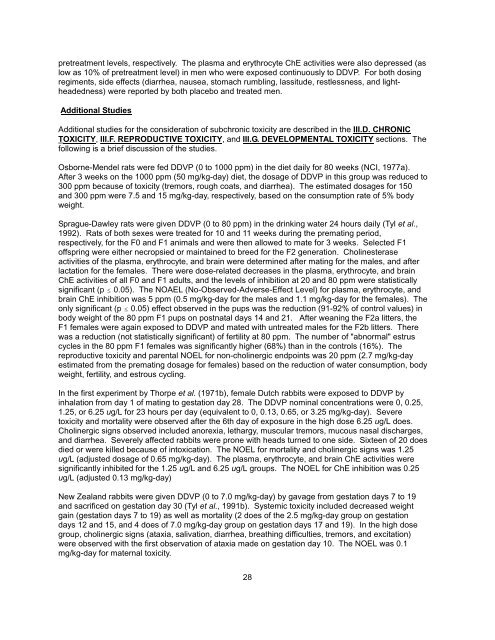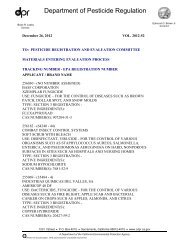Dichlorvos (DDVP) Risk Characterization Document - California ...
Dichlorvos (DDVP) Risk Characterization Document - California ...
Dichlorvos (DDVP) Risk Characterization Document - California ...
You also want an ePaper? Increase the reach of your titles
YUMPU automatically turns print PDFs into web optimized ePapers that Google loves.
pretreatment levels, respectively. The plasma and erythrocyte ChE activities were also depressed (as<br />
low as 10% of pretreatment level) in men who were exposed continuously to <strong>DDVP</strong>. For both dosing<br />
regiments, side effects (diarrhea, nausea, stomach rumbling, lassitude, restlessness, and lightheadedness)<br />
were reported by both placebo and treated men.<br />
Additional Studies<br />
Additional studies for the consideration of subchronic toxicity are described in the III.D. CHRONIC<br />
TOXICITY, III.F. REPRODUCTIVE TOXICITY, and III.G. DEVELOPMENTAL TOXICITY sections. The<br />
following is a brief discussion of the studies.<br />
Osborne-Mendel rats were fed <strong>DDVP</strong> (0 to 1000 ppm) in the diet daily for 80 weeks (NCI, 1977a).<br />
After 3 weeks on the 1000 ppm (50 mg/kg-day) diet, the dosage of <strong>DDVP</strong> in this group was reduced to<br />
300 ppm because of toxicity (tremors, rough coats, and diarrhea). The estimated dosages for 150<br />
and 300 ppm were 7.5 and 15 mg/kg-day, respectively, based on the consumption rate of 5% body<br />
weight.<br />
Sprague-Dawley rats were given <strong>DDVP</strong> (0 to 80 ppm) in the drinking water 24 hours daily (Tyl et al.,<br />
1992). Rats of both sexes were treated for 10 and 11 weeks during the premating period,<br />
respectively, for the F0 and F1 animals and were then allowed to mate for 3 weeks. Selected F1<br />
offspring were either necropsied or maintained to breed for the F2 generation. Cholinesterase<br />
activities of the plasma, erythrocyte, and brain were determined after mating for the males, and after<br />
lactation for the females. There were dose-related decreases in the plasma, erythrocyte, and brain<br />
ChE activities of all F0 and F1 adults, and the levels of inhibition at 20 and 80 ppm were statistically<br />
significant (p @ 0.05). The NOAEL (No-Observed-Adverse-Effect Level) for plasma, erythrocyte, and<br />
brain ChE inhibition was 5 ppm (0.5 mg/kg-day for the males and 1.1 mg/kg-day for the females). The<br />
only significant (p @ 0.05) effect observed in the pups was the reduction (91-92% of control values) in<br />
body weight of the 80 ppm F1 pups on postnatal days 14 and 21. After weaning the F2a litters, the<br />
F1 females were again exposed to <strong>DDVP</strong> and mated with untreated males for the F2b litters. There<br />
was a reduction (not statistically significant) of fertility at 80 ppm. The number of "abnormal" estrus<br />
cycles in the 80 ppm F1 females was significantly higher (68%) than in the controls (16%). The<br />
reproductive toxicity and parental NOEL for non-cholinergic endpoints was 20 ppm (2.7 mg/kg-day<br />
estimated from the premating dosage for females) based on the reduction of water consumption, body<br />
weight, fertility, and estrous cycling.<br />
In the first experiment by Thorpe et al. (1971b), female Dutch rabbits were exposed to <strong>DDVP</strong> by<br />
inhalation from day 1 of mating to gestation day 28. The <strong>DDVP</strong> nominal concentrations were 0, 0.25,<br />
1.25, or 6.25 ug/L for 23 hours per day (equivalent to 0, 0.13, 0.65, or 3.25 mg/kg-day). Severe<br />
toxicity and mortality were observed after the 6th day of exposure in the high dose 6.25 ug/L does.<br />
Cholinergic signs observed included anorexia, lethargy, muscular tremors, mucous nasal discharges,<br />
and diarrhea. Severely affected rabbits were prone with heads turned to one side. Sixteen of 20 does<br />
died or were killed because of intoxication. The NOEL for mortality and cholinergic signs was 1.25<br />
ug/L (adjusted dosage of 0.65 mg/kg-day). The plasma, erythrocyte, and brain ChE activities were<br />
significantly inhibited for the 1.25 ug/L and 6.25 ug/L groups. The NOEL for ChE inhibition was 0.25<br />
ug/L (adjusted 0.13 mg/kg-day)<br />
New Zealand rabbits were given <strong>DDVP</strong> (0 to 7.0 mg/kg-day) by gavage from gestation days 7 to 19<br />
and sacrificed on gestation day 30 (Tyl et al., 1991b). Systemic toxicity included decreased weight<br />
gain (gestation days 7 to 19) as well as mortality (2 does of the 2.5 mg/kg-day group on gestation<br />
days 12 and 15, and 4 does of 7.0 mg/kg-day group on gestation days 17 and 19). In the high dose<br />
group, cholinergic signs (ataxia, salivation, diarrhea, breathing difficulties, tremors, and excitation)<br />
were observed with the first observation of ataxia made on gestation day 10. The NOEL was 0.1<br />
mg/kg-day for maternal toxicity.<br />
28
















